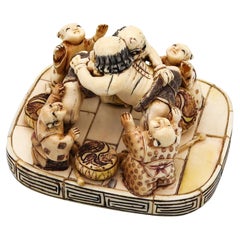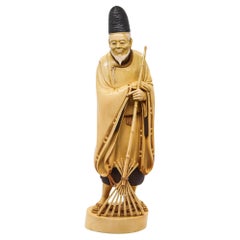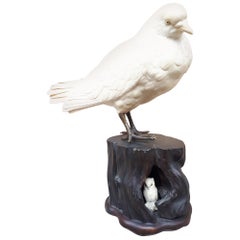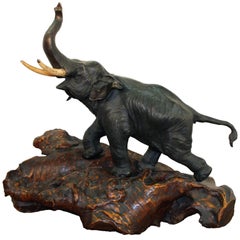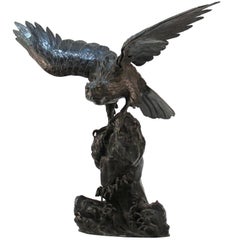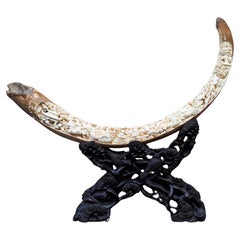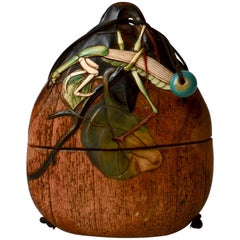Ivory Sculptures and Carvings
6
to
4
4
2
6
6
6
5
1
168
1,969
1,255
1,178
912
6
6
4
2
Material: Ivory
Japan 1900 Meiji Period Rare Carved Okimono of Two Sumo Fighters Signed
Located in Miami, FL
Japanese Okimono sculpture of a father and son.
A highly detailed sculptural composition, created during the Meiji imperial period (1868-1912), circa 1900. The composition displayed...
Category
1890s Japanese Meiji Antique Ivory Sculptures and Carvings
Materials
Ivory
Japan 1890 Meiji Carved Sculpture of a Dressed Monk With a Rake
Located in Miami, FL
A Japanese carved sculpture of a monk.
An outstanding antique tall sculpture, created in Japan during the Meiji period, circa 1890. The carving depicts the figure of a Japanese stan...
Category
Late 19th Century Japanese Meiji Antique Ivory Sculptures and Carvings
Materials
Ivory
Japan 1890 Meiji Carved Figure of Fortune God Daikoku As a Farmer With Coins
Located in Miami, FL
A Japanese carved sculpture of Daikoku.
Magnificent sculpture of the god of the fortune Daikoku, created in Japan during the Meiji period, circa 1890. The carving depicts the Japane...
Category
1890s Japanese Meiji Antique Ivory Sculptures and Carvings
Materials
Ivory
Ivory Okimono by Kofu, Japan Meiji era
Located in Saverne, Grand Est
Rare okimono carved in the thickness of an elephant tusk depicting a life-size pigeon. It stands on a hollow trunk, inside which hides an owl.
A small 4mm...
Category
1880s Japanese Meiji Antique Ivory Sculptures and Carvings
Materials
Ivory
Chinese 1900 Qing Dynasty Bodhisattva Altar Temple-Pagoda In Wood And Carvings
Located in Miami, FL
Buddhist altar temple-pagoda from the Qing Dynasty (1644-1911).
Fabulous and very rare, East Asian, Buddhist Altar Temple-Pagoda. It was created in China during the late Qing Dynast...
Category
1890s Chinese Qing Antique Ivory Sculptures and Carvings
Materials
Wood, Ivory
Pair Matching Ivory Chinese Dogs of Foo Matchstick Holders Silver Bases
Located in High Wycombe, GB
A Delicate Pair Of Ivorine Dogs of Foo Matching Matchstick Box Holders.
Bases Have Silver Mark Stamp.
Chinese guardian lions, or imperial guardian lions, are a traditional Chinese a...
Category
20th Century Chinese Chinese Export Ivory Sculptures and Carvings
Materials
Silver
Related Items
Japanese Meiji Period Bronze Elephant Sculpture on Burlwood Base
Located in New York, NY
A Japanese Meiji period bronze elephant sculpture on its original burl-wood base. Old repair to the tail; some paint chips to bronze trunk; unsigned.
Category
1880s Japanese Meiji Antique Ivory Sculptures and Carvings
Materials
Bronze
Japanese Meiji Bronze Sea-Hawk Sculpture
Located in New York, NY
A finely-cast large Japanese Meiji-period bronze sculpture of a sea-hawk with stretched-out wings, made in the 1880s. The eyes are gilded; both wings and the body of the hawk are det...
Category
1880s Japanese Meiji Antique Ivory Sculptures and Carvings
Materials
Bronze
Japanese Buddha Okimono Figure
Located in Nottingham, GB
In good condition
From a private collection
Free international shipping
Japanese Buddha Okimono Figure
Category
20th Century Ivory Sculptures and Carvings
Materials
Composition
Japanese Meiji Period Carved Wood Okimono Man with Rabbits
Located in Newark, England
The charming figure, carved from a single piece of wood is exceptionally carved showing the male figure with humorous expression holding two Rabbits one by the ears and the second under his arm. A third Rabbit stands at the feet of the male looking up, each rabbit with a different expression. The male figure is wearing traditional Japanese attire with his hair tied back stood upon a naturalistic base. The figure dates to the Meiji Period (1868-1912) circa 1900.
Notes The Rabbit is one of the 12 animals to feature in the Japanese Zodiac signs which follows the Chinese astrological system along with the Rat, Ox, Tiger, Rabbit, Dragon, Snake, Horse, Goat, Monkey, Rooster, Dog, Pig. Such division is connected with the Jupiter cycle around the Sun, which lasts about 12 years. As 2023 is the year of the Rabbit...
Category
Early 1900s Japanese Meiji Antique Ivory Sculptures and Carvings
Materials
Wood
Pair of Chinese Black Marble Contemporary Facing Foo Dogs Guardian Lions
Located in Yonkers, NY
A pair of contemporary Chinese black marble left and right facing foo dogs guardian lions on rectangular bases. Created in China during the 21st century, this pair of black marble gu...
Category
21st Century and Contemporary Chinese Ivory Sculptures and Carvings
Materials
Marble
Japanese Meiji Noh Mask in Carved Wood
Located in New York, NY
Japanese early Meiji period Noh theater mask made of carved wood with gofun layers. The piece was made in Japan in circa 1880 and is signed on the back. In great antique condition wi...
Category
1880s Japanese Meiji Antique Ivory Sculptures and Carvings
Materials
Wood
Japanese Meiji Bunraku Ningyo Puppet
Located in New York, NY
Japanese Meiji period puppet for the traditional Bunraku ningyo joruri puppet theater. The piece has a carved wood head and is adorned with richly detai...
Category
Early 1900s Japanese Meiji Antique Ivory Sculptures and Carvings
Materials
Textile, Wood
Chinese Pair Hand Carved Red Hardstone Mounted Foo Dogs
Located in Bishop's Stortford, Hertfordshire
A delightful and well carved pair Chinese red hard stone dog of Foo figures of miniature size dating from the first half of the 20th century. The figures stand raised on a solid hand...
Category
20th Century Chinese Ivory Sculptures and Carvings
Materials
Ceramic
Japanese Paloma Wood Carving Okimono of Jurojin
Located in New York, NY
A Japanese carved paloma wood Okimono of Jurojin (god of longevity with a turtle). A symbol of long life, the sculpture also depicts a young boy representing the beginning of life. Carved from one piece of boxwood with a beautiful rich patina. Jurojin originated from the Chinese Daoist god, the old man of the South Pole, he may have been a historical figure of the Northern Song Dynasty...
Category
Late 19th Century Japanese Meiji Antique Ivory Sculptures and Carvings
Materials
Boxwood
Chinese Qing Dynasty Altar Cabinet
Located in Nantwich, GB
Antique, late 19th century Chinese Qing Dynasty altar cabinet.
This beautifully restored altar cabinet, originally used to place offerings for ancestral worship holds three frieze dr...
Category
Late 19th Century Chinese Qing Antique Ivory Sculptures and Carvings
Materials
Brass
Japan 1890 Meiji Period Signed Assembling of Okimono with a Group of Skeletons
Located in Miami, FL
A signed Okimono from the Japanese Meiji period (1868-1912).
Very rare, unusual and large sculptural assembling of a dysplaying piece of okimono. Created in Japan during the imperial period of the Meiji (1868-1912). This extraordinary piece okimono sculpture depict a group of four intricately and realistically rendered carousing males skeletons representations (Gaikotsu) standing in several position.
One skeleton is crouched down playing with mouses in the floor. The second is seated resting in the other's back, peacefully smoking opium. The others two are fully standing in interacting position. The entire composition is arranged freely displayed on the wood base including a woven basket, apparently with food and four playfull mouses.
There are an extra five mouses in different positions, freely playing around, all of them with the eyes accented with carved black ebony.
The composition is displayed on a four-legged free form carved wood platform with an inlaid red plaque engraved with the artist's signature. The level of detail and the quality of the carving is truly exceptional.
Has an exact measurements of 216.15 mm by 139.7 mm by 359.41 mm (8.51 x 5.5 x 14.15 Inches).
After an extensive collection of data, comparables and references to this piece, we have only been able to find only three okimono sculptures like this, with similar themes and the same quality of work.
References Note: A similar carving of four skeletons playing an animated game of dominos, signed Shutaro in an inlaid rectangular red plaque, was sold in London by Christie’s South Kensington in October 14 2014, Lot 120 Sale 5546.
References Note: A similar carving with four skeletons in an otherwise typical victorian scene of a photographer and three sitters signed Shutaro in an inlaid rectangular red plaque, was sold in Edinburgh at Lyon & Turnbull in November 7, 2018.
References Note: A similar carving with five skeletons seated, playing cards and drinking, was sold in London by John Nicholson Fine Art on September 26, 2018.
Meiji period, is an era of Japanese history that extended from October 23, 1868 to July 30, 1912.The Meiji era was the first half of the Empire of Japan, when the Japanese people moved from being an isolated feudal society at risk of colonization by Western powers to the new paradigm of a modern, industrialized nation state and emergent great power, influenced by Western scientific, technological, philosophical, political, legal, and aesthetic ideas. As a result of such wholesale adoption of radically different ideas, the changes to Japan were profound, and affected its social structure, internal politics, economy, military, and foreign relations. The period corresponded to the reign of Emperor Meiji. It was preceded by the Keio era and was succeeded by the Taisho era, upon the accession of Emperor Taisho.
Okimono, is a Japanese term meaning for display an ornament; art object; or decorative object, usually displayed in a tokonoma or butsudan "Buddhist altar". It is an ornament or figure, especially one placed in a guest room. An okimono may be a small Japanese carving...
Category
1890s Japanese Meiji Antique Ivory Sculptures and Carvings
Materials
Wood
H 8.51 in W 14.15 in D 5.5 in
Japan 1890 Meiji Period Rare Carved Okimono Of A Father And Son Playing Signed
Located in Miami, FL
Japanese Okimono sculpture of a father and son.
Very rare and highly detailed sculpture, created during the meiji period (1868-1912) in the imperial Japan, circa 1890. This sculptural Okimono is very well realized and exceptionally proportionate. Show the figures of a father and a son playing, with happiness and smiling. The father hold a big basket at his back and both personages are wearing kimonos richly engraved.
This piece was made from a carving with exceptional craftsmanship and intricate details. This sculpture stand itself on his own base and have all retain of the applied ochre ink accents.
Measures: 130 mm by 45 mm by 53.3 mm (5.1 x 1.75 x 2.1 inches).
Weight: 81.30 grams.
Note: This kind of family scene is very rare to seen in nineteenth century japanese iconography.
Okimono
Is a Japanese term meaning for display an ornament; art object; or decorative object, usually displayed in a tokonoma or butsudan "Buddhist altar". It is an ornament or figure, especially one placed in a guest room. An okimono may be a small Japanese carving, similar to but larger than a netsuke. Unlike the netsuke, which had a specific purpose, the okimono is exclusively decorative and was displayed in the tokonoma. During the Meiji period, many okimonos were made for export to the West.
Meiji Period
This is an era of Japanese history that extended from October 23, 1868 to July 30, 1912.The Meiji era was the first half of the Empire of Japan, when the Japanese people moved from being an isolated feudal society at risk of colonization by Western powers to the new paradigm of a modern, industrialized nation state and emergent great power, influenced by Western scientific, technological, philosophical, political, legal, and aesthetic ideas. As a result of such wholesale adoption of radically different ideas, the changes to Japan were profound, and affected its social structure, internal politics, economy, military, and foreign relations...
Category
1890s Japanese Meiji Antique Ivory Sculptures and Carvings
Materials
Wood, Paint
H 2.1 in W 5.1 in D 1.75 in
Previously Available Items
Carved Mammoth Ivory Tusk, Chinese Crafts
Located in Saverne, Grand Est
Large mammoth tusk and its wooden support, all finely hollowed out and carved.
An exceptional piece that will delight any collector of Asian art. Much more impressive in real life th...
Category
20th Century Chinese Ivory Sculptures and Carvings
Materials
Ivory
Inro, Japanese, 19th Century
Located in Stockholm, SE
An inro, Japanese, made of wood and with inlays of colored ivory in the shape of a grasshopper and partly lacquered, 19th century.
An inro is a traditional Japanese case for holdi...
Category
19th Century Japanese Antique Ivory Sculptures and Carvings
Materials
Ivory, Wood, Lacquer
Chess Set
Located in Houston, TX
Indian bone pieces carved probably in Burma, and more than likely for Chinese carvers for an export. Natural bone and dyed red. The chess set is 19th century. Some repairs and age cracks. The king stands at 3 3/4 "high. The carving patters consist of flowers and more complex Chinese scenes. Fine wood chess...
Category
Mid-19th Century Indian Modern Antique Ivory Sculptures and Carvings
Materials
Ivory, Wood
Delightful Standing Woman Figure from Japan
Located in Berlin, DE
A very fine carving from Japan, Meiji period circa 1900. On rectangular wooden base. Rich gilded, with inlaid mother-of-pearl. Hands, feet, head and a pole ...
Category
Late 19th Century Japanese Japonisme Antique Ivory Sculptures and Carvings
Materials
Gold
Read More
12 Calming Spaces Inspired by Japanese Design
From cherry-blossom-adorned walls paired with glamorous lighting to wood-paneled ceilings above checkerboard-patterned chairs, these 12 spaces seamlessly blend Eastern and Western aesthetics.
Rodrigo Rivero Lake’s Mexico City Showroom Is a Museum-Worthy Trove of Spanish Colonial and Asian Antiques
The dealer and curator has spent the past 50 years amassing a collection of exceptional art, furniture and architectural elements that trace the cultural influence of the Spanish empire from Europe to the Americas and beyond.
Recently Viewed
View AllMore Ways To Browse
Antique Thai Buddha
Asian Chinese Display Stand
Asian Tree Sculpture
Red Lacquer Carving
Lapis Lazuli Stone Carved
Chinese Wooden Carvings
Japanese Antiques Dragon Furniture
Antique Japanese Rings
Asian Bronze Figural Sculpture
Temple Japanese Buddhist
Century Small Buddha
Jade Carvings Antique
Cloud Carving
Hexagon China
Asian Plaque
Bronze Buddha Hands
Jade Carving Sculpture
Qing Jade
